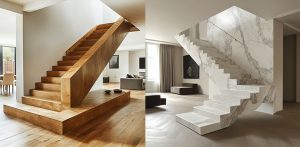Staircase Building Regulations UK: Complete Guide

Regal Stairs, the renowned staircase manufacturing company in the UK brings to you exclusive details on staircase building regulations in the UK. In section “K” of the building regulations UK, all the points regarding staircases are laid out. Here the staircase is referred to as a domestic staircase or private stair. A domestic staircase refers to a staircase that is intended for use in a residential dwelling. We have tried our best to cover the details in a perfectly simple and understandable manner. But to be sure, feel free to contact your building inspector or staircase manufacturing company in case of confusion.
Staircase Building Regulations UK: Complete Guide
- Rise, Going, and Angle Regulations
The horizontal base where we keep our foot is called the tread and its length is called going. Two treads are separated by a rise. The angle at which the staircase is aligned is known as the pitch angle or stair pitch. Here are the regulations that need to be followed while constructing are:
- The height of the individual rise should be between 150mm and 220mm.
- The length of the individual going must be between 220mm and 300mm. This does not include nosing.
- The Pitch or the angle of the stairs cannot be bigger than 42 degrees.
Also, the length of all risers should be the same. You cannot have some at 200 mm while other risers at 210 mm. But in case, there is a landing space between two flights, then the risers may vary in length in different flights of stairs. Since there is a restriction on the pitch angle i.e. 42 degrees, the minimum length of the individual going depends on individual rise. Let’s understand this with the help of an example.
Example:
In a home, a staircase needs to be constructed and the height between two finished floors is 2600 mm. The height of individual riser cannot exceed 220 mm, this will give us:
The minimum number of risers = 12 (2600 / 220 = 11.818) of height 217 mm (2600/12 = 216.667) each.
The maximum number of risers = 17 (2600 / 17.3333) of height 153 mm (2600/17 = 152.941) each.
Now, the minimum length of the riser is 220 mm. If we use this with a rise of 217 mm, the pitch of the stair comes out to be 44.4ᵒ. But we need it to be a minimum of 42ᵒ. We keep the angle and rise height fixed, this will give us the tread length to be 240.9 mm or 241 mm. Now this configuration will make things fall under building regulations completely.
- Width Regulations
In the building regulations, there are no fixed guidelines for the width of the staircase. However, for a normal flight of stairs from the entrance that connects multiple rooms on the floor, the width should not be less than 800 mm. Most of the staircase manufacturers prefer going for a width between 850mm and 950mm as it offers good space to get things up and down. For loft staircases connecting the loft space, the acceptable width is 600mm, but you can always have a good space between 700mm – 750mm.
But for a staircase with turns, it’s possible that the width of the two flights can be different. As depicted in the picture, the width of the stairs from the beginning is 800mm and after the turn it changes to 875mm. It is completely acceptable.
- Landing Regulations
Landing space is categorised as:
- the flat platform which is either a part of the turn between two flights of stairs or where the staircase changes direction.
- Also, the area of the top and bottom of the stairs connecting floors.
According to the regulations the length and width of the landing space which are a part of the floor must have dimensions at least equal to the lowest width of the narrowest flight of stairs.
Just have a look at this example, here the width of the staircase is 750mm, so the space at the bottom and top of the floor should be at least equal to 750mm. It can be more than that also.
- Nosing Regulations
Nosing is the area of the going or tread that protrudes and overhangs the riser. As such there is no maximum or minimum values for that overhung part. However, most of the staircase manufacturing companies prefer 20mm to be an excellent value. Adding a nosing is a choice and not a compulsion.
- Headroom Regulations
Headroom is the space above the staircase, and the staircase should maintain a consistent height at all points. According to the building regulations, there should be a minimum headroom of 2m at all the points of the staircase when measured from the pitch line. A pitch line is an imaginary line that is drawn by connecting all the front of the treads. The line can be seen in the picture connecting all the treads.
Usually, people follow the wrong method i.e. they measure the height from the top of the tread. According to building regulations, you need to measure the height from the staircase’s pitch line. There may arise some difficulties while installing a staircase in compact spaces such as lofts, here you need to seek approval from a building control officer or assistance from the staircase manufacturing company.
Decreased headroom for lofts with sloping ceilings
There may be certain exceptions as well. Let us consider a loft conversion. In some loft spaces, there may not be 2m of headroom available. Things are acceptable as long as there is a headroom of 1900mm measured from the centre of the staircase even if shoulder height headroom is 1800 mm. This is only applicable in the case of lofts.
- Kite Winders Regulations
Kite winders are triangular or trapezoidal steps that are added to a turn to minimise the space taken by the staircase. Certain regulations are laid for the use of kite winders for domestic purposes. From the figure, it’s clear that every kite winder staircase has a mixture of both winder and straight treads.
The individual going of the treads is measured by drawing an arc starting from the middle of the lowest flight to the middle of the upper flight. You can see the arc in the figure.
Building Regulation for Each Winder Going
- The winder treads of the staircase must be equal to or greater than the straight treads.
- The going of all winder treads must be equal.
Example.
Let’s understand by taking the example of the winder staircase having straight treads of 242 mm. The going of the kite winder should be equal to that of the straight treads, and this can be ensured by drawing the arc. Any value less than this will fail to comply with the building regulations. The individual going of the kite winders can be greater than 242 mm. The regulations apply to all winders within the winder box.
Two Kite Winder Boxes
There is a standard rule for all treads in a staircase which states that “Twice the individual rise plus the going (2R +G) must be between 550mm and 700mm”. This rule can create a problem with a winder box having two kite winders. For example: Taking the total height as 2600mm and rise height of 217mm, the straight treads measure 241 mm for a pitch of 42ᵒ. As you can see from the image, both the kite winders are equal and greater than straight treads. They meet the building regulations for sure. But, by applying the above-stated rule between treads and risers, i.e. 2R + G comes out to be 778 mm (2*217 + 344). 778 mm is far more than 700mm. So, in this case two kite winders of same length may not comply.
Inside Tread Dimension:
Building regulations also state that a minimum tread length at the narrow end should be 50 mm. Have a look at the figure given where you can clearly see that the tread 6 and tread 4 both fall within the range i.e., they are 90.22 mm and 112.78 mm, respectively.
- Handrails & Balustrades
According to the staircase building regulations UK, the handrail should be positioned at a minimum height of 900mm and a maximum being 1000mm. The height is measured either from the floor or the pitch line.
Height For Which Handrail Is Required
There should be a provision for a handrail to the sides of the flight where the height or drop is more than 600mm. This means you can have just two steps without a handrail. Rest in all cases, a handrail is necessary.
Gap Between Spindles
As per the domestic staircase building regulations, a sphere of 100mm diameter should not be able to pass through the gap between the spindles. This means that the maximum gap between the balustrade spindles should not be greater than 99mm or should be less than 100 mm.
Horizontal Rails
Horizontal rails are preferred by many people as they are economical and easy to install. There aren’t any strict rules regarding the use of horizontal rails or ranch rails but building regulations forbid the use of such rails. The reason being that the use of such guardians in the dwellings where children under five years of age live could be risky. Such railings can easily be climbed by the children, and they may get hurt.
- Obstacles Regulations
All or any obstacles should be at a minimum gap of 400mm from the staircase. For the doors, their location or the swing of the door should bear a minimum gap of 400 mm from the bottom of the staircase.
- Regulations for Open Riser Stairs
For the open riser staircase, the building regulations state that a sphere of 100mm should not be able to pass through the gap between the treads. If the gap is big, it can be minimised by using mini risers or chrome riser bars. This will ensure that the gap stays within the limit and the staircase abides by the regulations.
- Regulations for Space Saver Stairs
There may be areas such as loft or other compact areas, where the standard stairs are not possible to construct. So, there is a provision of space saving stairs also known as alternating tread stairs or paddle stairs. According to the building regulations, these space saving stairs should be used when they are serving a single room.
These stairs should be used as your last option. Speak to your staircase manufacturer for other feasible options. If nothing works out, then this should be taken as your last resort. The regulations for space saving stairs state that the maximum rise should be 220 mm and a minimum going of 220mm for the longer side of the tread. However, the rule of 42ᵒ of stair pitch does not apply here. Also, a space saving staircase must be accompanied by a wall handrail or standard handrail on both sides.
Planning a new staircase or want to renovate your existing one? Regal Stairs have the perfect experience and expertise to deliver you the best staircase solutions that meet your needs and comply with building regulations. Speak to us today.
Want a Staircase You’ll Love Forever?
We’ll help you create something amazing and unique. We Promise!


